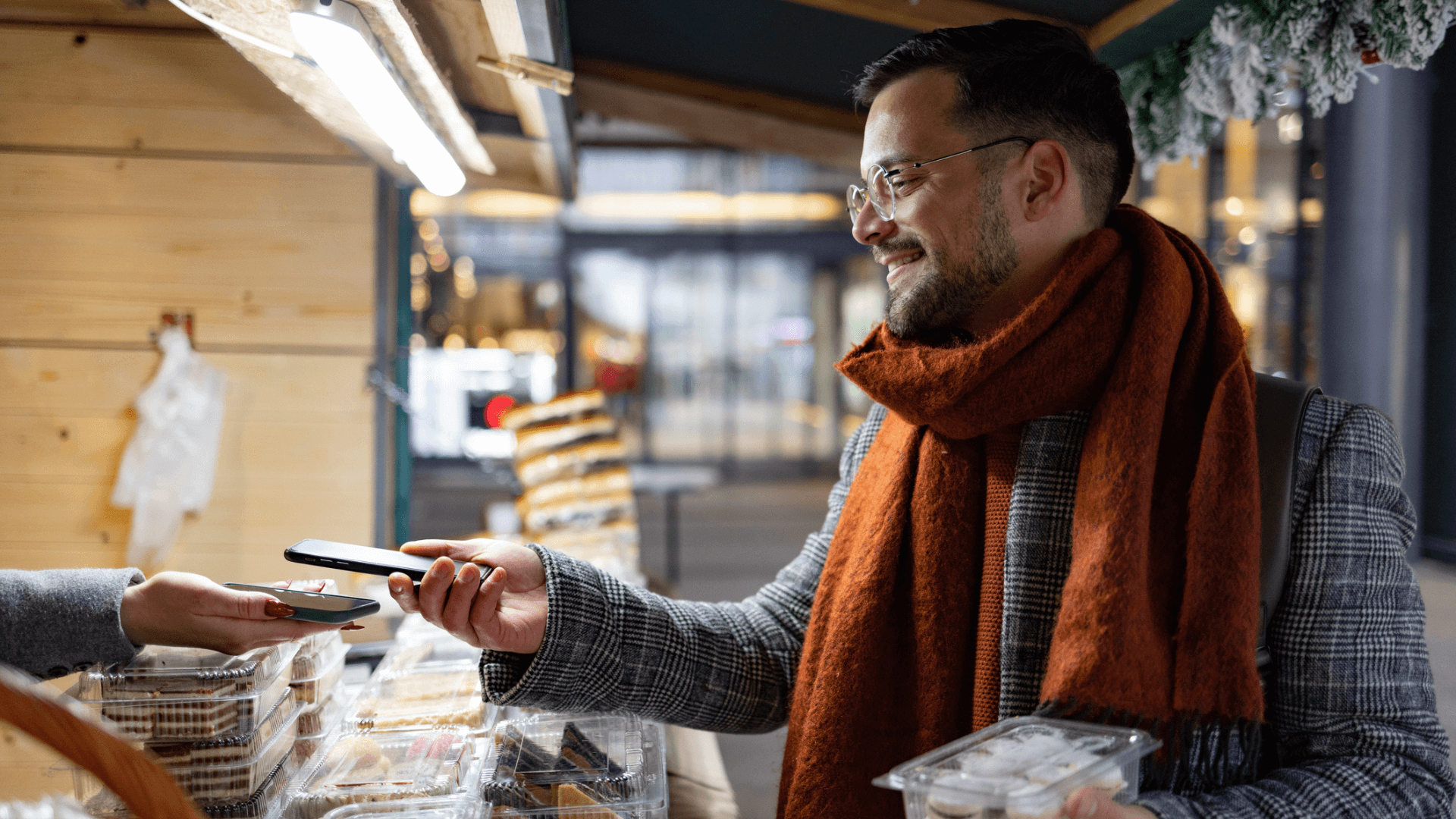Local Memo: Instagram Gets Indexed, TikTok Transition, and Google AI Answers
Is Your Brand’s Local Social Media Management Strategy Up to Par?
Is Your Brand’s Local Social Media Management Strategy Up to Par?
Localized content receives 12x the engagement as content that is not considered localized. Additionally, 76 percent of U.S. consumers have purchased a product they saw in a brand’s social media post. If your multi-location enterprise is not leveraging local social media, consider what you’re missing out on.
Within this blog, we’ll define local social, share tactics your brand can leverage to improve its local social strategy, and explain what it takes to win more customers. Let’s get into it!
A Look Into Local Social
To understand what local social is, we must first define localized marketing. Localized marketing promotes your business and brand to a targeted local area and community. For instance, how you market and connect with an audience in Washington will differ from how you’d engage with your target audience in Georgia.
Local social is the social media arm of localized marketing. Local social uses social media platforms to connect local businesses or agents with local consumers to create a sense of community, improve brand awareness, and generate more sales.
6 Tactics To Improve Your Local Social Efforts
Now that you understand local social media, let’s explore six ways to improve your strategy. After, we’ll reveal what to consider when choosing a solution to help your brand manage its social efforts locally at scale.
1. Leverage the Right Platforms
One of the first and most important things you must do when building a local social plan is to determine which platforms your brand will focus on. Understanding your target audience’s demographics, like age, ethnicity, interests, gender, income levels, and more, will impact which social media platforms you prioritize. Below, you’ll find a breakdown of the most popular social media platforms for each age group in 2021.
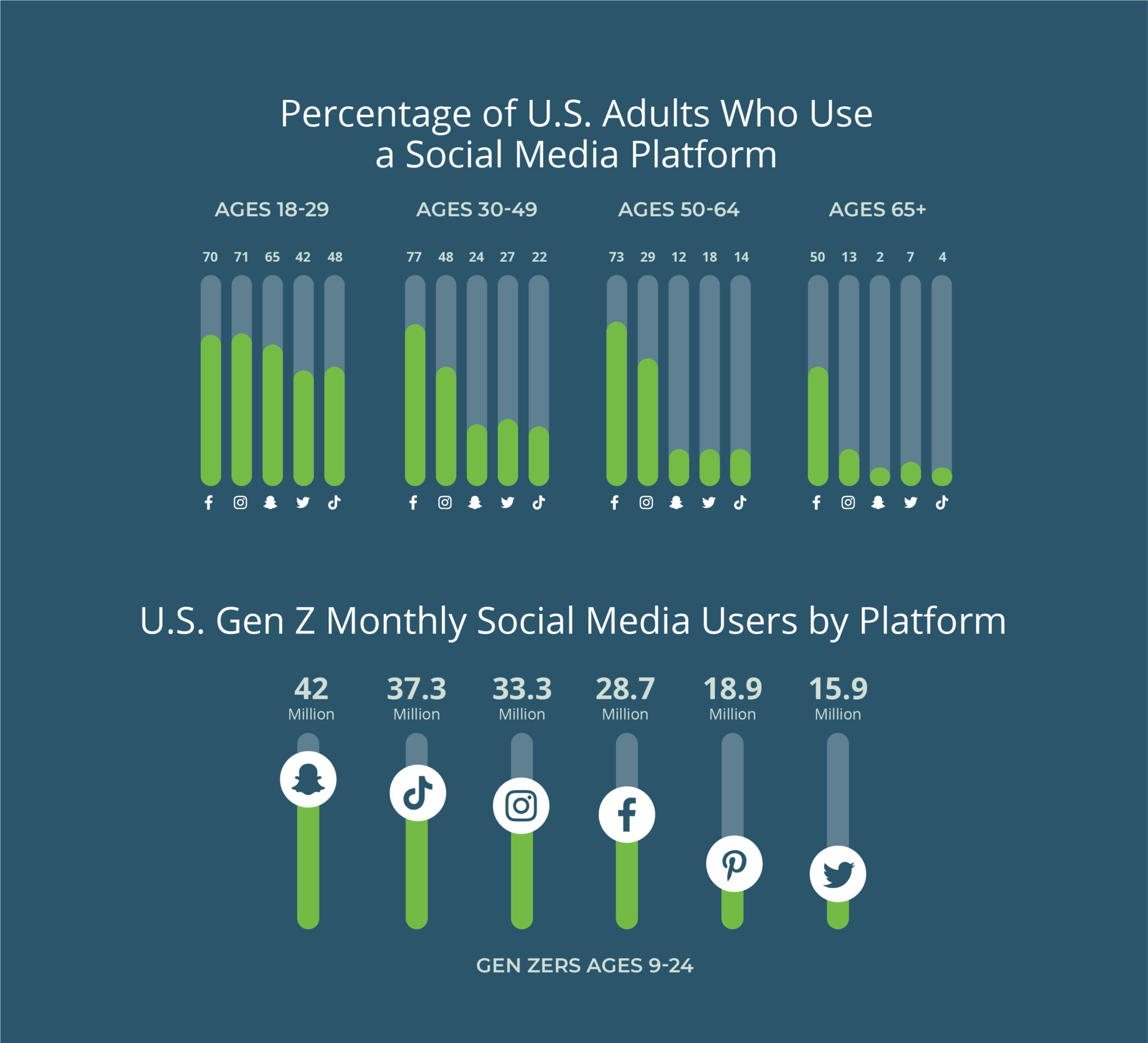
It’s also worth considering the size of the platform. For instance, Facebook boasts 2.98 billion monthly active users and is an excellent platform for brands with multiple locations, due to your ability to create individual Facebook pages for each local store. Once you determine which platforms your brand will leverage, it’s time to start thinking about content.
2. Develop Engaging Content
As mentioned, localized content performs better than content that is not considered localized. When deciding which content to create, an emphasis on local is non-negotiable. Beyond that, it’s essential to consider what content will resonate with your target audience.
For instance, Gen Z gravitates towards short videos, with 40 percent preferring reels, stories, or TikTok videos when seeing brand ads on social media. Therefore, you’ll want to post short and informative videos if your target audience is Gen Z or younger millennials.
SOCi data also found that on Facebook, posts with videos have twice the correlation with engagement as posts with photos. The data speaks for itself. When developing local social content, videos are a great place to start.
Developing videos takes time and resources, so if your brand is looking for other types of local social content to develop, consider the following:
Quizzes and polls:
Generate local quizzes and polls. You can have followers vote on their favorite places to visit in a city. You can also ask industry-related questions. These quizzes, polls, and answers can be stand-alone posts or featured stories.
Product or services spotlights:
Share content around your products or services. This can be informational video tutorials or day-in-the-life content with a user leveraging your products or services.
Testimonials and user-generated content (UGC):
Eight in ten consumers say UGC highly impacts purchase decisions. With the customer’s permission, publish written or video testimonials.
Employee spotlights:
Publish employee success stories or “get to know you” posts to help acquaint followers with your local staff.
Giveaways and contests:
Host contests or giveaways such as a gift card to your business location or a free class, appetizer, or product if followers share a post. Below is an example of Jersey Mike’s Subs highlighting their upcoming customer appreciation campaign.
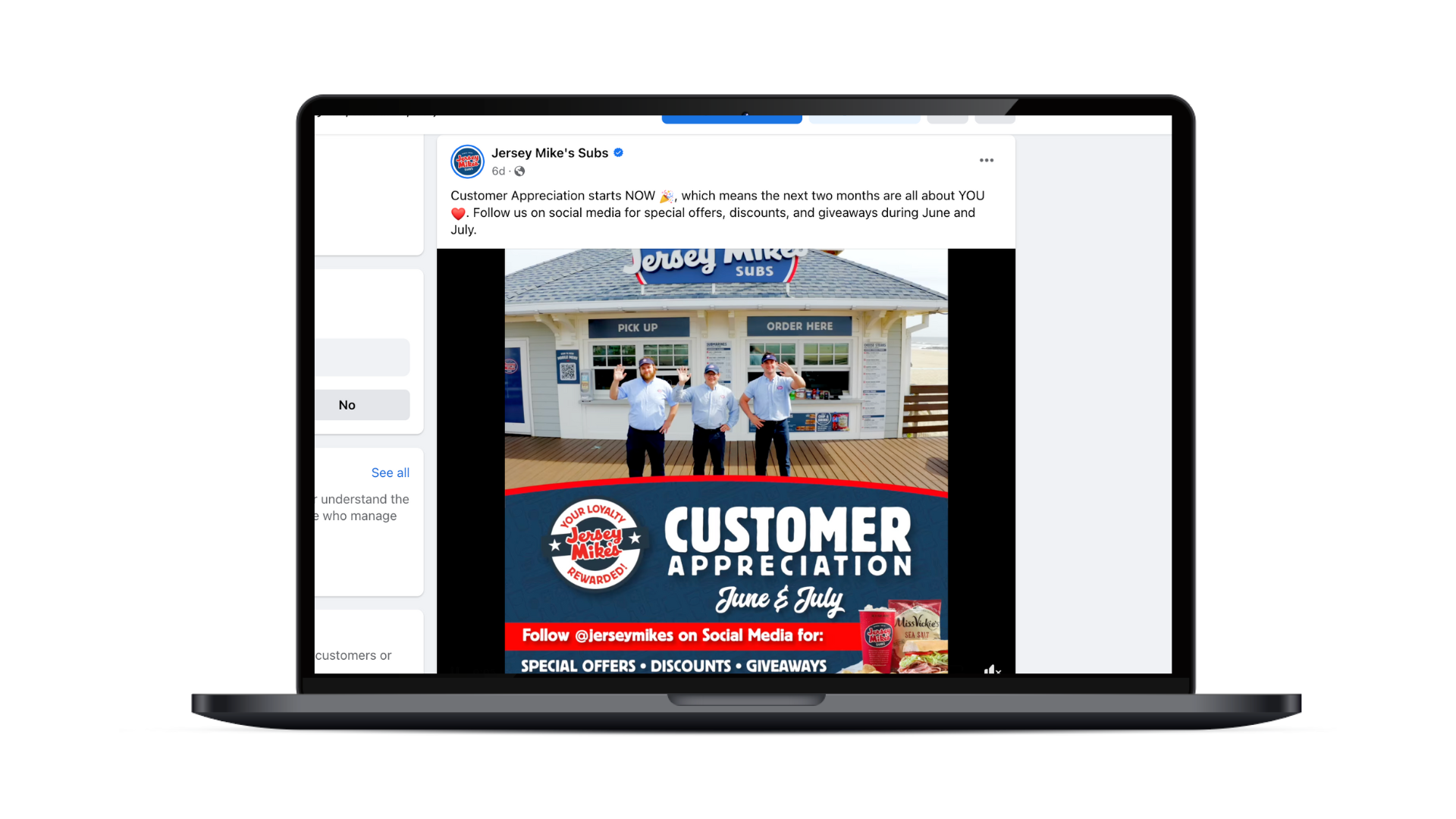
For a more detailed discussion on types of local social media content your brand can leverage, download our Localized Social Content Guide.
3. Interact With Potential Customers
Once you start creating local social content, it’s crucial to begin engaging with your target audience on your social platforms. This includes but is not limited to responding to users’ comments on your posts, leveraging Facebook Messenger to answer customers’ questions, and re-sharing relevant content.
For instance, in the example below, you’ll see Bar Louie responding to a comment they received from a customer on one of their local Facebook pages.
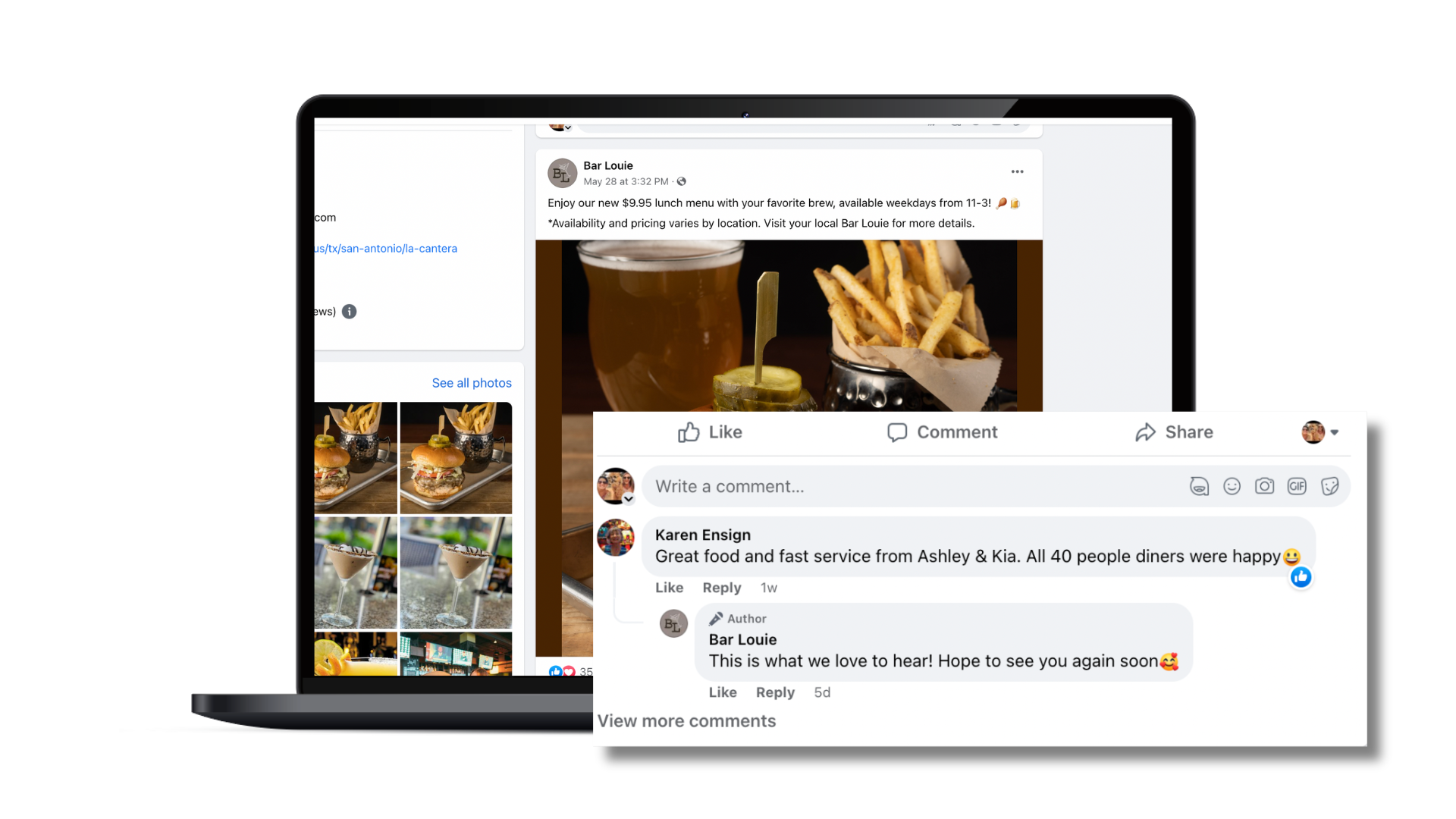
Consumers like to feel heard and seen, and interacting with them on your local social platforms does exactly that. Furthermore, these interactions show potential customers that you care about current or previous customers’ opinions and reviews. This increases your local stores’ likelihood of obtaining new customers.
4. Consider Local Advertising
In 2021, 50 percent of Gen Z and 58 percent of millennials in the U.S. stated that social media advertising influenced their purchasing decisions. Furthermore, the advertising revenue generated by Facebook worldwide in 2021 was $114.93 billion. Advertising on social media platforms like Facebook, Instagram, and Twitter can help your brand stand out from competitors and win more customers.
Most social media platforms allow you to:
- Create custom campaigns
- Target relevant audiences
- Include eye-catching calls to action
- Retarget those that have already interacted with your brand
Your brand can customize these ads across business locations, allowing you to target based on location. For instance, here’s an example of a brand targeting Instagram users in the Dallas area. As you can see, the ad is customized to its Dallas audience.
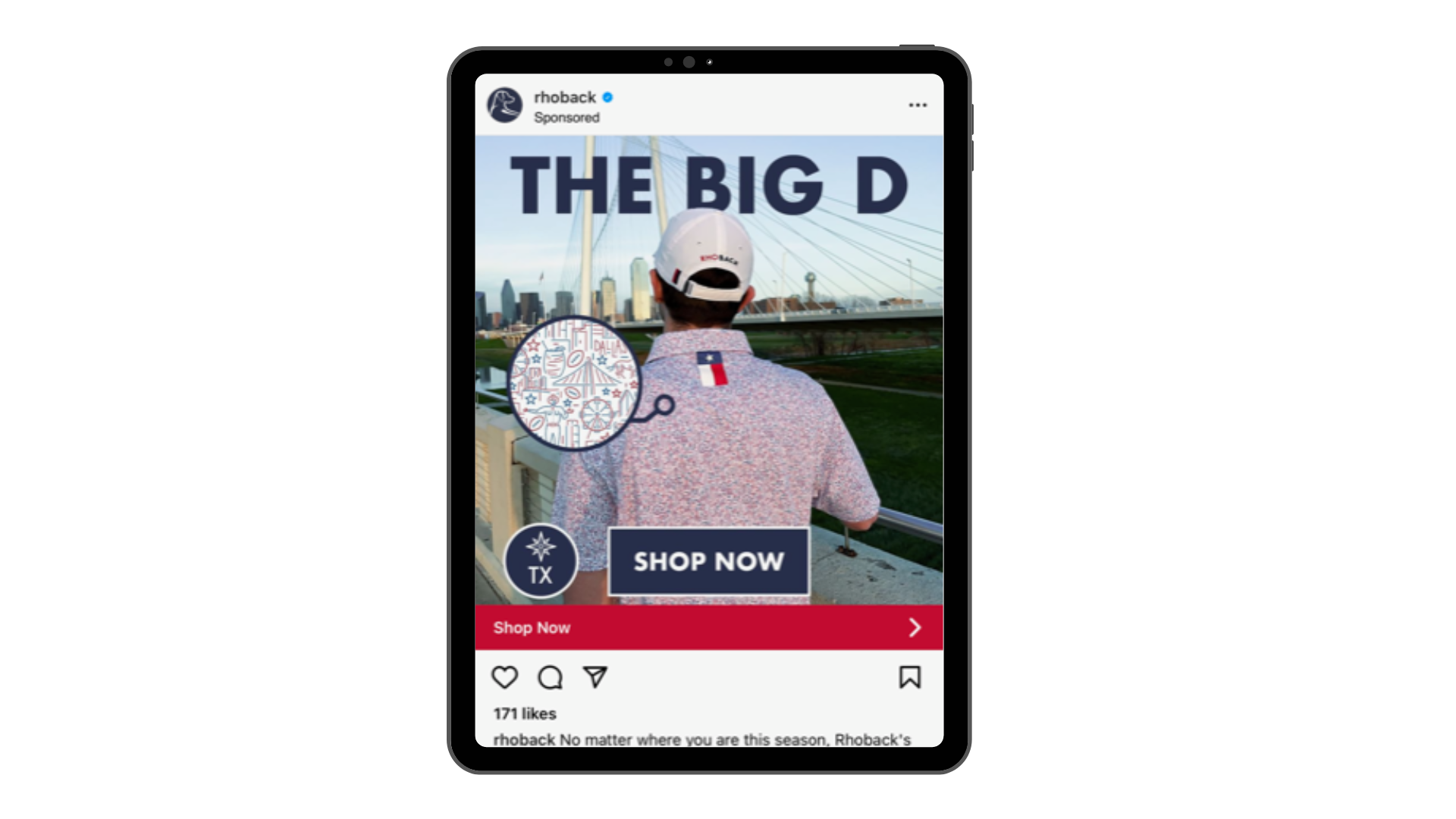
It’s also worth noting that these social platforms have in-depth analytics allowing you to measure ad performance and adjust for better targeting. Check out our blog on social advertising for a more detailed look into developing local social advertising campaigns.
5. Utilize Messaging Capabilities
Many local social platforms also have messaging capabilities that add value to your local social strategy. For instance, if your brand has local Facebook pages or individual Instagram accounts for each business location, are you checking their messages? Similar to replying to comments received on local social, responding to direct messages is a must.
Those managing the local accounts should be responsible for monitoring your messages and replying when appropriate. Additionally, some chatbot marketing solutions provide the opportunity to integrate with local social platforms. If you can reach your target audience through local social, where they’re likely already spending their time, why wouldn’t you?
Each platform gives you access to a different audience bases and have various messaging features. When choosing your software partner, consider where they can help you reach local audiences. The more places, the better!
6. Analyze Data and Make Improvements
Lastly, a comprehensive local social media strategy without insights and reporting isn’t complete. As a multi-location enterprise, your brand must understand how its current social efforts perform locally and adjust accordingly.
The image below shows an example of SOCi’s Facebook Business Manager, which typically provides social media insights into our content’s performance. Note, we’ve removed the metrics for the purpose of this blog.
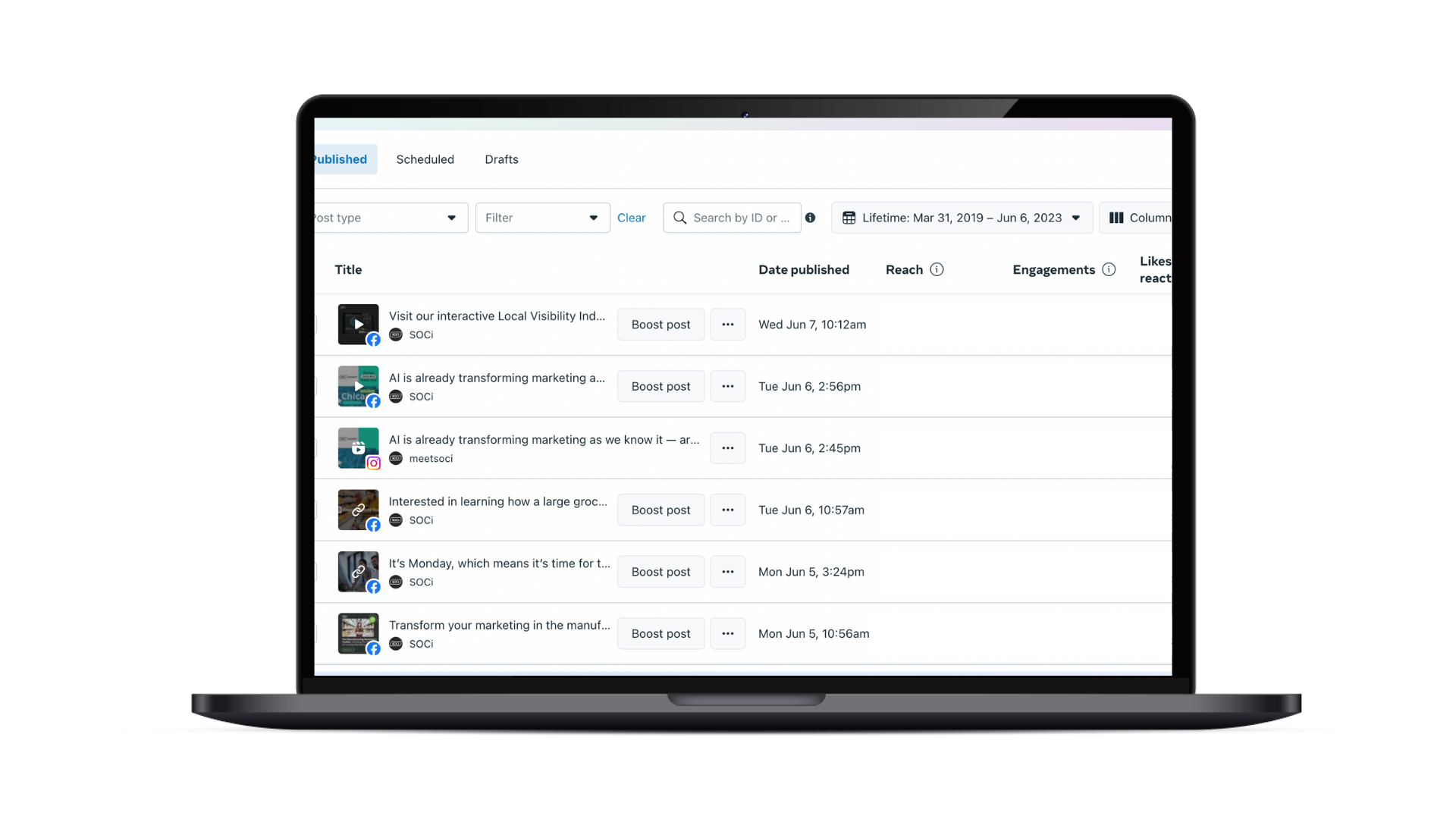
For instance, is one of your business locations crushing social engagement while another is finding it challenging to get any engagement? If so, what are the two locations doing differently? This insight can help your brand provide a list of local social media best practices for all locations.
On the other hand, one type of social media content may perform better in one local area than another. While providing best practices is essential, it’s also necessary to give your locations some freedom to test different types of content to see what works best for them.
Your brand should analyze data at both the corporate and local levels weekly, monthly, and quarterly. While analyzing data is a must, it is only relevant if your brand makes changes based on your findings.
Remember, focus on efforts that are working, and spend less time and money on those that aren’t.
Win More Customers With a Strong Local Social Strategy
There’s a lot that goes into building a stand-out local social strategy. As a brand with 100s or 1,000s of locations, managing social media efforts across all of your locations is challenging. That’s where a solution like SOCi Social can help!
SOCi Social enables multi-location enterprises to manage and deploy localized content at scale while maintaining brand consistency at both the enterprise and local levels. It also allows brands to elevate their digital presence by allowing them to publish to all major networks with localized content.
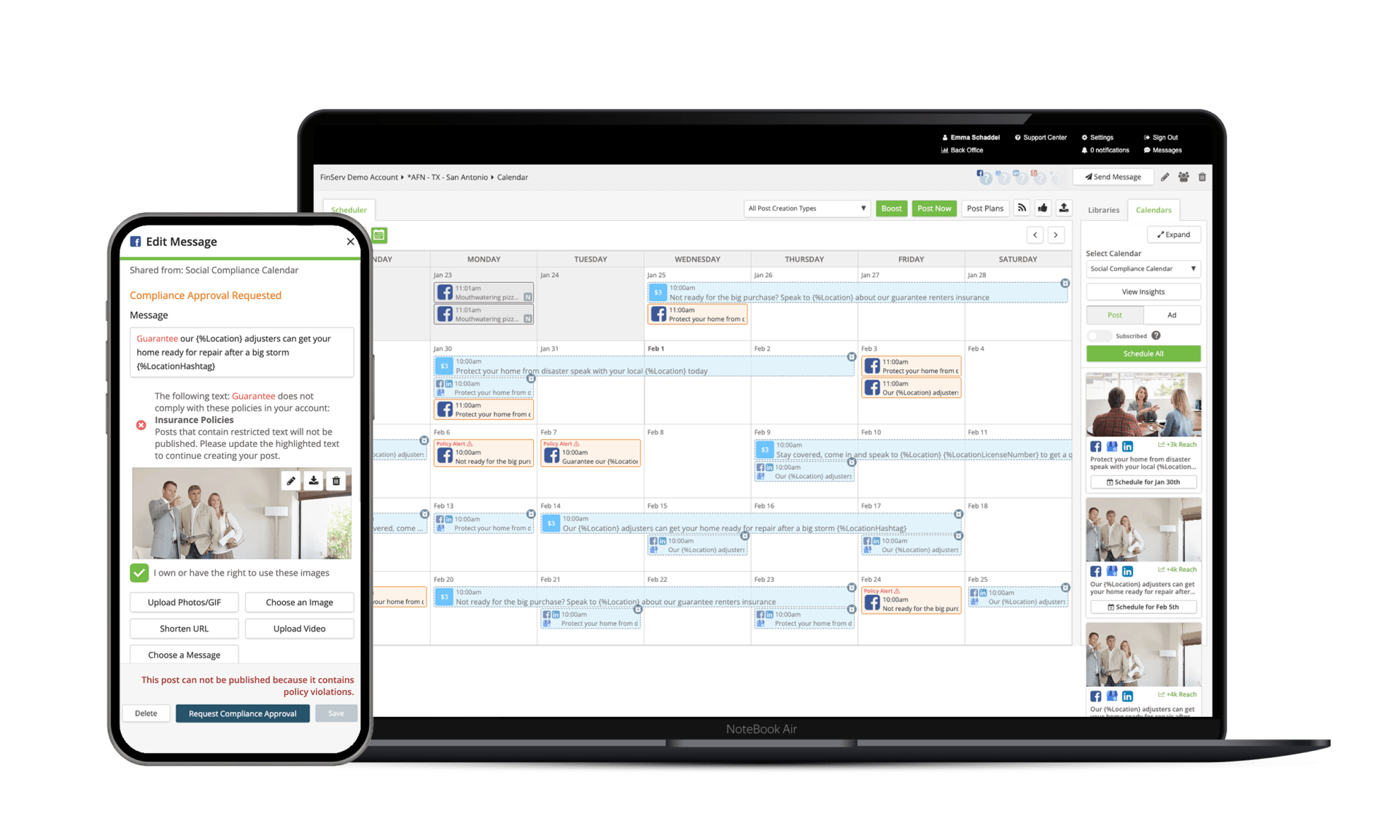
With SOCi Social, you can also analyze account, group, or location performance to ensure that your content gets the most engagement for your brand — and make adjustments accordingly.
Additionally, SOCi Smartbot is a Facebook, Google, and SMS Messaging chatbot that delivers localized, proactive responses to commonly asked questions and can drive calls-to-action, including calls, website clicks, appointment setting, purchases, and more!
Moreover, SOCi SmartBot combines advanced machine learning and natural language processing to generate conversation trees and branches. This helps your multi-location brand deliver a localized and conversational chatbot experience — across every location.
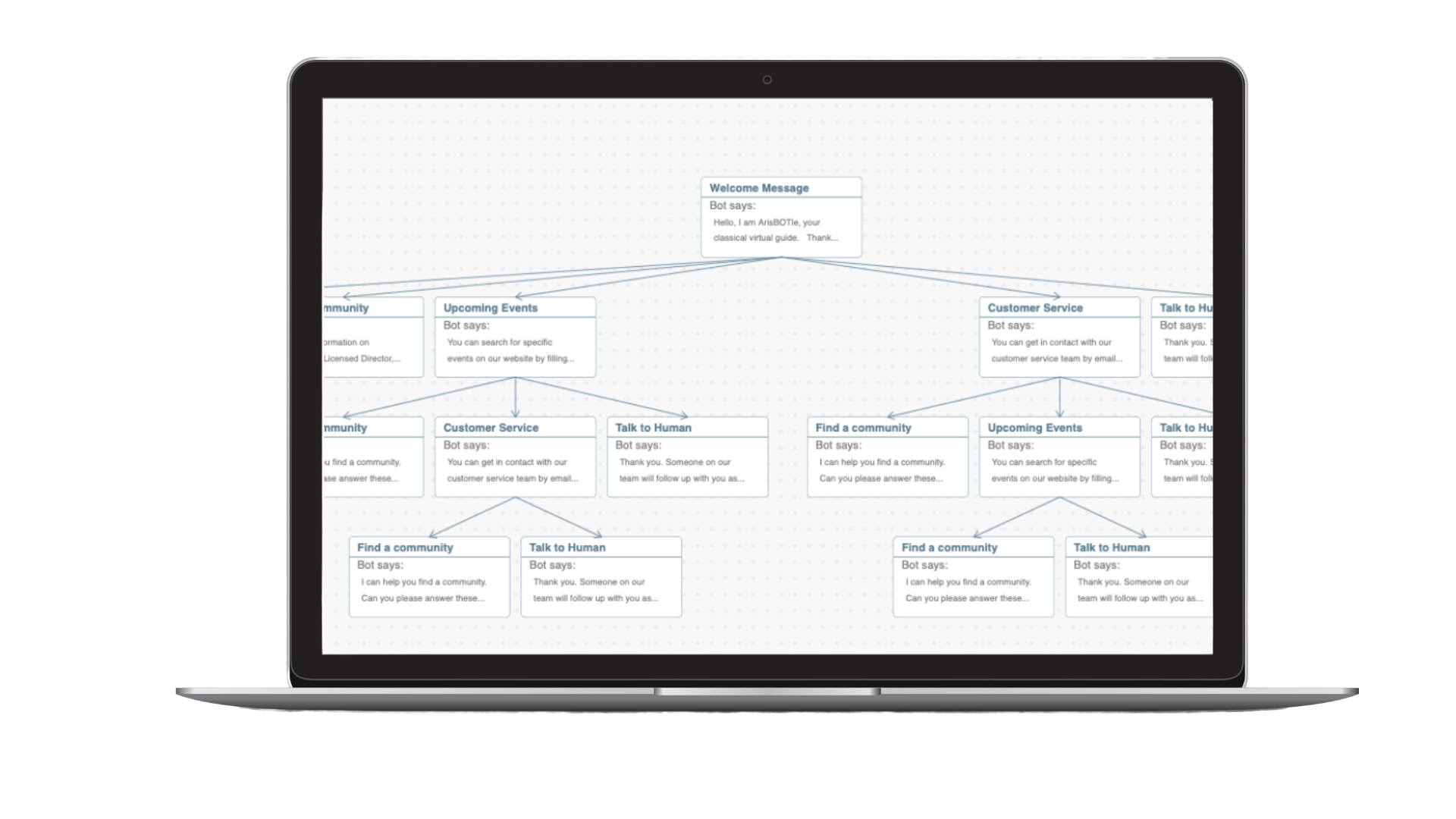
Lastly, SOCi Ads PLUS empowers marketers to effectively manage local social ad campaigns across their local social profiles. Using our dynamic text and patent-pending dynamic image technology, you can deploy a single ad that will auto-populate with local text and images across your locations.
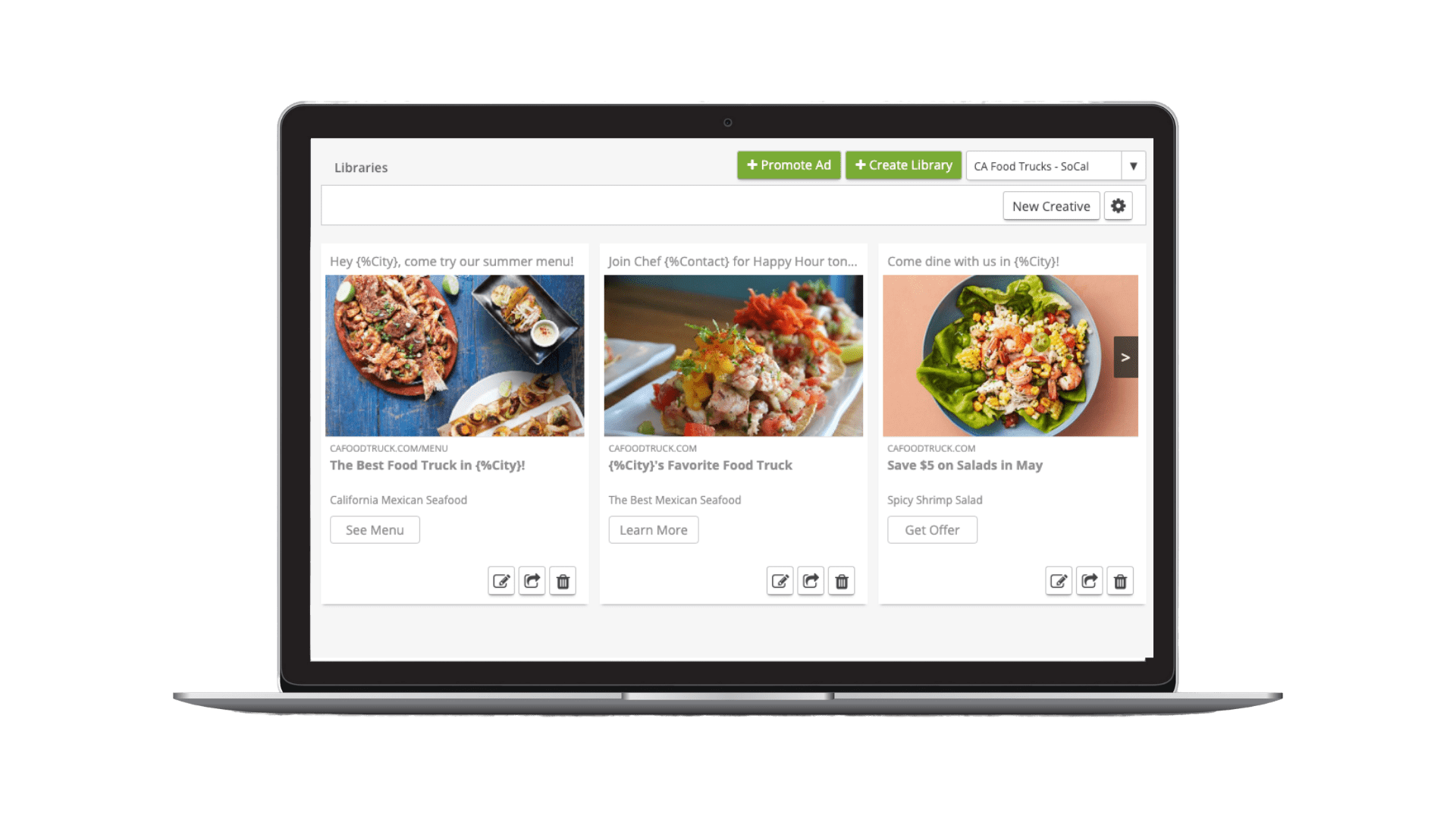
Request a demo today for additional insight into how these products can help you level up your local social efforts and beyond!






